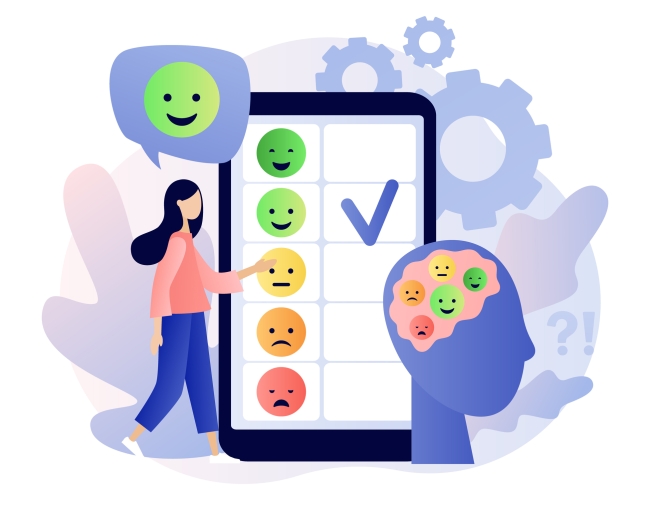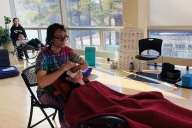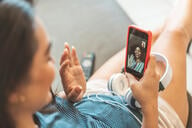You have /5 articles left.
Sign up for a free account or log in.

Digital mental health solutions have grown since the start of the COVID-19 pandemic, but research remains limited on the effectiveness and accessibility of these tools.
Marta Sher/iStock/Getty Images
Student mental health is a growing concern for higher education administrators and practitioners as national rates of anxiety, depression and loneliness among college learners grow. Surveys show mental health is impacting students’ enrollment decisions, their academic success and even how they consider their college experience.
Administrators say they’re aware of the issue, but institutional investments in resources have yet to reach all students equitably.
A 2023 Student Voice survey by Inside Higher Ed, conducted by College Pulse, found only one-third of college students had used any of their institution’s mental health services, including in-person counseling, telehealth and off-campus referrals.

Sara Abelson
The Hope Center at Temple University published a report in May, commissioned by the Ruderman Family Foundation and in partnership with the Healthy Minds Network and Boston University, that analyzed nine common digital mental health interventions at U.S. higher education institutions.
In this episode of Voices of Student Success, host Ashley Mowreader spoke with one of the report’s four authors, Sara Abelson, assistant professor and senior director of training and education at the Hope Center. Abelson digs deeper into what digital mental health interventions are, how they aid student well-being and the overarching need for more data regarding these interventions and the students using them.
An edited version of the podcast appears below.
Inside Higher Ed: If you can just sort of lay the landscape for us, what are these interventions and where did they come from?
Abelson: Digital mental health interventions refer to the use of digital technologies for mental health support prevention and treatment. They provide behavioral or psychological strategies through technological features like websites or mobile applications, apps, virtual reality online platforms.
Some digital mental health interventions allow students to self-manage symptoms, while others use some form of support either to increase engagement or to provide additional intervention, but they really range.
Many are preventative resources—they help students with less acute needs or potentially reduce the need for mental health treatment—while others are providing mental health treatment and helping students who are already experiencing mental health symptoms.
That gets into the specifics. But maybe to just zoom out a little further before diving right into the specs of digital mental health interventions, I would just highlight that I think we’ve really seen growing and increasing use of technology to support mental health.
We see that nationally, internationally and certainly at college campuses, I think, as our data demonstrates, students’ needs around mental health have been growing. Rates of depression, anxiety have nearly doubled in the last decade, and more and more folks are turning to technology and thinking about how technology can help, again, both prevent problems and help students who are already struggling with mental health symptoms.
Inside Higher Ed: I wonder if you can talk about that combination. It’s not necessarily that technology is replacing in-person care, counseling and things like that, but how it works in supplement to those services?
Abelson: I would say that was one of the key findings from our work.
In our interviews, we spent a lot of time speaking with decision-makers and mental health leaders at college campuses, and heard again and again that these technologies are not replacing, and cannot replace, in-person services at colleges and universities. But there there’s a hope that they can supplement and that they can complement what is already going on.
And I say hope because one of our findings from our report is that we need more research and data and evidence to understand exactly what they’re doing and who they’re reaching.
But I think we heard from many decision-makers that they are sometimes pairing these with their counseling center so that they can meet students’ needs, say, outside of business hours if their counseling center isn’t available at those times, or perhaps they have a population of students who speak different languages, and they aren’t able to serve their needs in their campus counseling center.
They might look for digital and mental health interventions that could meet the needs of those students, or they’re also looking to complement and think about holistic support for students.
So again, maybe the counseling center is really focused on treating students who are experiencing mental health symptoms, but they’re looking for a digital solution that would help prevent problems, prevent students from needing the counseling center, help students who have subclinical symptoms, who can strengthen their mental health and their positive psychological well-being and improve their students’ academic outcomes that way.
There’s a range of ways that colleges are considering these interventions, but absolutely as complements and supplements to in-person services.
Inside Higher Ed: The report found that there wasn’t a lot of data around what these interventions can do or what they’re doing. Can you talk first about what are those metrics of success when we’re talking about mental health interventions? And then, how does that tie into these digital interventions and what we’re looking for in talking about data?
Abelson: It really depends on which digital mental health intervention you’re considering, or in general, which mental health intervention you’re considering. Because there’s a lot of potential outcomes and metrics of success, and college leaders really have an opportunity to, again, think about a holistic model of support, to think about preventing problems and treating problems, and you’d want to look at different metrics and outcomes.
So some digital mental health interventions are designed [for] and serving to reduce symptoms, like reduce symptoms of depression, reduce symptoms of anxiety among students who are experiencing an anxiety disorder … whereas other interventions are really designed to support students or prevent problems from developing.
Those interventions you might look at, “Are they increasing student sense of social support?” which is known to be really important for mental health. “Are they increasing students’ sense of belonging? Are they improving positive mental health? And is this sort of metric and outcome or flourishing or other types of outcomes that you might consider?” It really depends.
And I would say that those metrics outcomes translate, so that might apply to an in-person program or intervention at a college or university, or a digital intervention. And in both instances, you want to not only look at outcomes and sort of what it’s achieving that way, but also we talk a lot about usage in our research and guide.
We know there’s a difference between efficacy—so whether an intervention produces a result in ideal circumstances, like a laboratory or a randomized control trial—and what happens in real-world settings, when you roll it out on a college campus, who participates for how long do they participate, what benefits are realized, given how they are engaging? Those are really important things to look at, again, both with digital and health interventions or in-person services as well.
Inside Higher Ed: What are the key findings of this report? What does that mean for higher ed?
Abelson: I want to highlight to this work was very much a collaborative project. I’m delighted to be here today, but also really want to give a shout-out to my close colleagues and regular collaborators from the Healthy Minds network, Dr. Sarah Lipson and Daniel Eisenberg, who I did this work with, alongside Dr. Steven Schuler, Ashley Johnson, Michelle Liu and Shannon Ogden, all a big, big collaboration to get this work out there.
We really concluded that, although significant research has demonstrated that digital mental health interventions can be effective at improving mental health, the majority of widely used interventions in college settings have limited direct evidence of effectiveness and student populations.
So again, just to phrase that differently, outside of working with college students, many digital interventions have been studied and shown to be effective, but when we looked at specifically the ones that are currently being commonly adopted at many U.S. college campuses, that there really is a lack of studies of their effectiveness with college students. We highlighted a need for more rigorous studies including experimental designs to, again, look at: What are they achieving? How effective are they? How do they work for diverse populations and institutional settings?
That’s another thing we found is there’s really a need to look more closely at how they’re working across the range of students that are utilizing them. We also continue to need more research to understand user uptake and engagement. As we’ve rolled these out in real time, in real life on college campuses, how are students engaging with them and participating over time?
Inside Higher Ed: When we talk about digital mental health interventions supplementing counseling services, most often those counseling centers who may need services to be supplemented are those that may be underresourced. They might be [in] rural locations and they can’t have a huge counseling staff, or they might have a very diverse student population, like you mentioned, speaking different languages. I thought it was interesting that metrics like access and diverse populations weren’t being tracked, because we’re talking about these services as especially good for those reasons.
Abelson: I think you’re raising great points. I think one thing going on is that this has all happened very quickly.
Research takes time to do, and I think some of that is just catching up. We had a global pandemic that drastically changed the landscape overnight; these interventions started being developed more quickly, colleges and universities started using them more quickly, I’m not sure we’ve ever seen a faster pivot, in terms of this space [mental health for college students].
I think there is interest in the work, and many are seeing the need for it. And it’s just taking some time to research, do it and get it out there. We just heard from some colleagues in response to the report, so they reached out to say, like, “Oh, we’re studying this, we’re looking at this, we’re wanting to examine how diverse student populations are using these technologies.”
But I will also say, these are long-standing problems, like our mental health services have not always equitably served our populations. We know that students of color are far more likely to be struggling with symptoms of a mental health disorder and not accessing care. And that applies to whether you’re talking about in-person services or digital services.
I think there’s a hope that these applications and interventions will better serve those populations. But there really is a need to sort of involve them in the work and the design from the front end and to be asking these questions and collecting the data to see whether that hope and that possibility that those not being served or being underserved by campus counseling centers are being reached and better served by digital interventions.
Inside Higher Ed: Another element highlighted in the report was funding for these interventions. How should administrators be critical in choosing different interventions?
Abelson: I think there’s a need for the decision-makers and those who are investing the funds to really demand the data and evidence to ask the hard questions. To not just pick an app because it looks good or promises good outcomes. But to really say, “Where have you rolled this out? What [does] the user engagement and uptake look like? What outcomes have been delivered where this intervention is being implemented?”
There’s some of it where, yes, there’s like pandemic funds available and important investments were made. And this is not to discourage investments in mental health. I think the data and evidence is clear that students are struggling, and those struggles have increased, and we all need to be doing more. And so I really do think, when the funds over all aren’t enough, and aren’t sufficient—we as a country and internationally underinvest in mental health compared to physical health.
And so when the funds are limited compared to the scope of the challenges and the need, we need to be really critical and careful about the investments and making sure that where we do invest, it’s the best investment—effective investments to be driving improvements and outcomes for students.
Inside Higher Ed: Where do you hope this report pushes the conversation around tech for mental health services?
Abelson: We are always gonna be champions for more data and evidence about what actually works. This guide on digital mental health interventions is really part of a larger initiative and work that I’m doing in partnership with, again, my colleagues at the Healthy Minds network, Dr. Sarah Lipson and Dr. Daniel Eisenberg, and as part of our larger dedication to helping college and university leaders and decision-makers and funders really know what works and access the evidence that does exist in that space. And also create more evidence and understanding of what actually works to move the needle and improve outcomes.
I hope we continue to get more of the data and evidence. As I mentioned, this is a space that has evolved quickly, and we’ve got to catch up with some of those things.
I also hope we continue to prioritize the needs and inclusion of diverse student populations. We’ve talked about that here. But I think that needs to continue to be a top priority. I think there’s really a chance to focus on the students that are not being served by our current systems, and we have really important population-level survey data to know who that is.
We do that work at the Hope Center, surveying and studying: What are the population needs on a college campus when it comes to student basic needs? We do that work at the Healthy Minds network, understanding what are student needs, who’s not being served by current services, who’s not accessing care? I think there’s a chance to really focus on those students and populations as we do this work.
One other piece I would add is that I hope technology and digital solutions can be a part of helping us connect students to the full comprehensive set of holistic supports they need. I think too often we do our student success work in silos. You’ve got one initiative focused on mental health, we have another focused on basic needs, we have another focused on advising and credentials, and students don’t encounter one issue at a time.
We see in our Hope Center survey data that 64 percent of students who are facing housing insecurity are also experiencing food insecurity, 72 percent of students experiencing significant mental health symptoms are also experiencing basic needs insecurity. I feel like technology has a potential to really help get students the care and the resources they need across issues. And I’m excited by that potential. I think there’s more work to do to get there and to achieve that. But that’s one space I hope we continue to go with this work.
Inside Higher Ed: And having efficacy data is also important, not only like you mentioned in finding which interventions are serving the right students, but also in helping identify students who are not using those services and making sure that access is a priority. So as we’re looking at data from the research side, there’s also the institutional investment in making sure that that data is used cohesively across the holistic system to look at, like you said, basic needs, academic interventions, etc.
Abelson: Yes, yes. We work closely with colleges and universities at the Hope Center through our Hope Impact Partnerships. Figuring out how to actually collect the data and use the data and translate the data into action—it’s a constant challenge.
We spend so much time and energy in collaboration with colleges working to do that. It’s a challenge at the state level, too. I just came from so many conversations of states trying to figure that out. I think that, yeah, looping it back into sort of continuous quality improvement is such a challenge. And it’s such a need, especially as this work continues to evolve, student needs are changing, the solutions available are changing—you really do need to have your systems right to have the data, understand what’s happening and update that over time.
Inside Higher Ed: Speaking of student needs, we’re seeing a lot of younger, like those traditional high school into college-age students, feeling lonely and isolated. And some of that is tied to social media and the digitalization of their worlds. Do you think there’s ever a risk in this digitalization of mental health care as well that it will create a bigger digital bubble?
Abelson: That is a great question. I feel like, to answer that question, I, a little bit, have to step out of my research expert role and more put on my mom hat.
I don’t think anyone has the answer there. I think we all have to be working together collaboratively to figure out how to harness technology for good, right, and not for bad when it comes to mental health. And I think we need more and are getting more evidence to understand: Where is it causing harm? Where is it isolating young people? Where is it leading to divides and where is it bringing people together? Where is it connecting students who are otherwise feeling isolated in their communities? Where is it helping us effect change as we deliver and scale interventions?
I think one is never going to replace the other. I think that can’t be said enough. I appreciated you opening with that—that this is really going to be about pairing in-person engagement effectively with technology for the benefits it brings.
I don’t think we really have answers yet on how to make it not be a bubble, how to get the students who aren’t getting into in-person care but have the right in-person support for those who that’s going to benefit.
I do think we need to do a better job of turning to students and asking them and listening in this space. I’ve just come from several student panels where they just do a brilliant job of emphasizing the extent to which [they] need both and how continuing to engage in person continuously over time is so important to their health and well-being. And they are on technology and will be using technology and we can’t ignore technology if we’re going to be serving our students up today. I think it’s always a both-and, and we ought to do more listening to the students voices and their direction on the path forward.
Listen to previous episodes of Voices of Student Success here.




